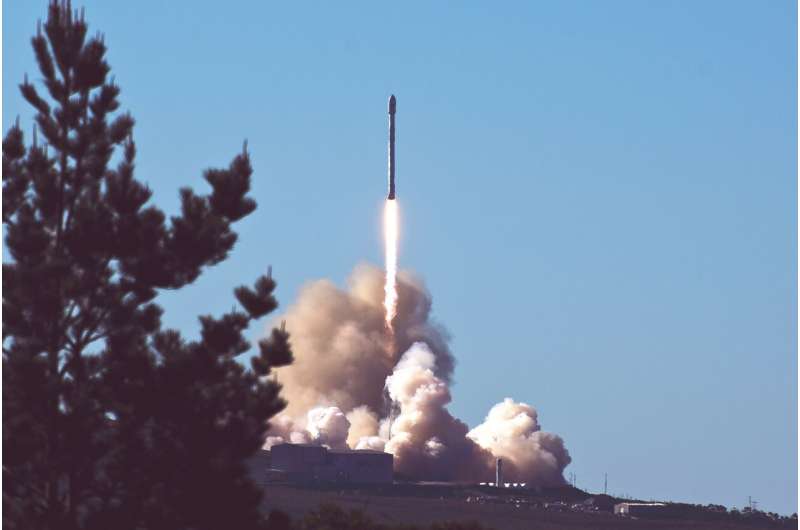It was among a litany of fixes SpaceX had to tackle. That launch ended with SpaceX sending up the command to self-destruct after the upper stage Starship was not able to separate from the first stage Super Heavy booster.
The pad adjustments meant adding more than 35,000 cubic feet of steel-reinforced, high-strength concrete below it, Musk said, but also the introduction of a massive water-cooled, steel flame deflector that's "basically two thick plates of steel that are welded together with channels going through it," he said.
"You basically have this water-cooled steel sandwich, and there are perforations in the top, so it will actually shoot a lot of water out," he said. "Think of it as a gigantic upside-down shower head. It's going to basically blast water upwards while the rocket is over the pad to counteract the massive amount of heat from the booster."
Musk said SpaceX's efforts were "going for overkill" to ensure the ability for quick turnaround on launch
Nearly seven months later, SpaceX and Super Heavy launched again and still managed to suffer not one, but two explosions. Still, it was deemed incrementally more successful than the first attempt as the Starship's upper stage managed to separate from the booster and actually fly into space but not make orbit before the end of its insertion burn.
The booster successfully fell away several seconds after separation before it exploded over the Gulf of Mexico. SpaceX later announced the upper stage's self-destruct system had activated near the end of its burn.
Still, the launch pad remained relatively intact, meaning SpaceX has already prepped for its next orbital launch attempt. It has rolled out the next Starship upper stage called Ship 28 to a nearby suborbital launch pad for testing for what is expected to be an early 2024 launch, even though technically the rocket has been grounded by the Federal Aviation Administration after the second launch's doubly explosive end.
"The FAA will oversee the SpaceX-led mishap investigation," the FAA stated after the launch. "A return to flight of the Starship Super Heavy vehicle is based on the FAA determining that any system, process, or procedure related to the mishap does not affect public safety.
NASA has a vested interest in Starship and Super Heavy achieving success. A version of the rocket is tasked with taking NASA's Artemis III mission astronauts to the lunar surface. That mission still on the official NASA timeline for no earlier than December 2025 would slip if Starship isn't ready yet.
NASA Administrator Bill Nelson said he was encouraged by the launch.
"Congrats to the teams who made progress on today's flight test. Spaceflight is a bold adventure demanding a can-do spirit and daring innovation. Today's test is an opportunity to learn—then fly again. Together @NASA and @SpaceX will return humanity to the moon, Mars & beyond," Nelson wrote on X after the launch.
The company needs to successfully achieve its first orbital launch test as well as dozens more uncrewed test flights, the introduction of an inflight refueling process that will be needed for its trip to the moon, and successfully perform a test landing on the moon before NASA will give the green light for its use on the Artemis III mission.
Between now and then, SpaceX will be shifting launches from Texas test flights to operational flights from Kennedy Space Center.
At both sites, the 469-foot-tall launch integration tower, which Musk has referred to as "Mechazilla," is designed to not only support the launch without suffering destruction between launches but also withstand a return landing capture of the Super Heavy booster with the aid of two pivoting metal arms called the "chopsticks."
Any damage from such a launch and landing, though, at KSC could threaten NASA's ability to launch crewed missions on the Falcon 9 rocket. So SpaceX is building out a second crew-capable launch tower at nearby Cape Canaveral Space Force Station's Space Launch Complex 40 and duplicating its launch pad engineering improvements in Texas before KSC's first Starship launch.
SpaceX has not announced a timetable for when the Space Coast might see its first Starship launch.
"What a great time in human spaceflight to now be talking about a single company launching a single vehicle and having multiple launch pads or runways to choose from," said Sarah Walker, SpaceX's mission management director for its Dragon spacecraft program.
With a backup option in place, it allows some leeway for SpaceX's Starship launch plans.
"SpaceX currently is making modifications within the Launch Complex 39A pad perimeter to support Starship launches while maintaining the ability to launch Falcon 9 and Falcon Heavy missions," NASA said in a statement after the most recent Starship launch. "SpaceX's activities are covered by its agreement for the pad's use."
For now, SpaceX is only allowed to build out the infrastructure at LC-39A.
"Launching and landing will involve further review and approval, to include construction of a launch pad that meets NASA's safety and environmental requirements," NASA said in a statement. "NASA currently is evaluating an update to the 2019 environmental analysis for Starship operations at LC-39A, to include operational changes as well as additional needed infrastructure in support of the Starship program."
That said, NASA notes that the FAA is the final regulatory authority for launch licenses for Starship when the time comes that it would need to launch commercial missions from KSC.
"We anticipate that it would do so for Starship launches from LC-39A," NASA said.
2023 Orlando Sentinel. Distributed by Tribune Content Agency, LLC.



